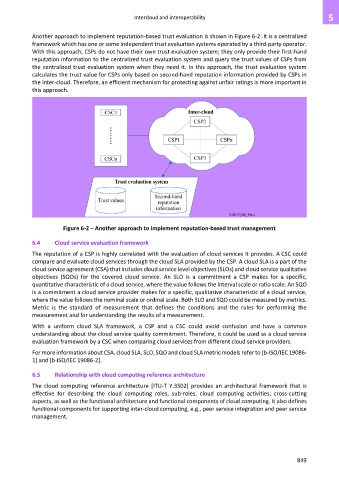Page 857 - Cloud computing: From paradigm to operation
P. 857
Intercloud and interoperability 5
Another approach to implement reputation-based trust evaluation is shown in Figure 6-2. It is a centralized
framework which has one or some independent trust evaluation systems operated by a third-party operator.
With this approach, CSPs do not have their own trust evaluation system; they only provide their first-hand
reputation information to the centralized trust evaluation system and query the trust values of CSPs from
the centralized trust evaluation system when they need it. In this approach, the trust evaluation system
calculates the trust value for CSPs only based on second-hand reputation information provided by CSPs in
the inter-cloud. Therefore, an efficient mechanism for protecting against unfair ratings is more important in
this approach.
Figure 6-2 – Another approach to implement reputation-based trust management
6.4 Cloud service evaluation framework
The reputation of a CSP is highly correlated with the evaluation of cloud services it provides. A CSC could
compare and evaluate cloud services through the cloud SLA provided by the CSP. A cloud SLA is a part of the
cloud service agreement (CSA) that includes cloud service level objectives (SLOs) and cloud service qualitative
objectives (SQOs) for the covered cloud service. An SLO is a commitment a CSP makes for a specific,
quantitative characteristic of a cloud service, where the value follows the interval scale or ratio scale. An SQO
is a commitment a cloud service provider makes for a specific, qualitative characteristic of a cloud service,
where the value follows the nominal scale or ordinal scale. Both SLO and SQO could be measured by metrics.
Metric is the standard of measurement that defines the conditions and the rules for performing the
measurement and for understanding the results of a measurement.
With a uniform cloud SLA framework, a CSP and a CSC could avoid confusion and have a common
understanding about the cloud service quality commitment. Therefore, it could be used as a cloud service
evaluation framework by a CSC when comparing cloud services from different cloud service providers.
For more information about CSA, cloud SLA, SLO, SQO and cloud SLA metric models refer to [b-ISO/IEC 19086-
1] and [b-ISO/IEC 19086-2].
6.5 Relationship with cloud computing reference architecture
The cloud computing reference architecture [ITU-T Y.3502] provides an architectural framework that is
effective for describing the cloud computing roles, sub-roles, cloud computing activities, cross-cutting
aspects, as well as the functional architecture and functional components of cloud computing. It also defines
functional components for supporting inter-cloud computing, e.g., peer service integration and peer service
management.
849

